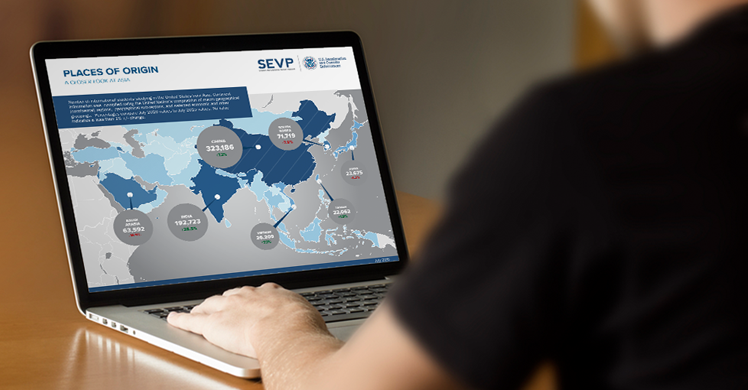ICE releases quarterly international student data
WASHINGTON — There are 1.11 million international students with F (academic) or M (vocational) status studying in the United States according to the latest "SEVIS by the Numbers," a quarterly report on international student trends prepared by the Student and Exchange Visitor Program (SEVP), part of U.S. Immigration and Customs Enforcement’s (ICE) Homeland Security Investigations (HSI).
The report, released Tuesday by SEVP, highlights July 2016 data from the Student and Exchange Visitor Information System (SEVIS), a web-based system that includes information about international students, exchange visitors and their dependents while they are in the United States.
Based on data extracted from SEVIS July 7, international student enrollment at U.S. schools increased 5.5 percent compared to July 2015. In July, there were 8,673 U.S. schools with SEVP certification to enroll international students, about a two percent decrease from the previous year.
Forty-two percent of international students studying in the United States, equaling almost 467,000 individuals, were enrolled in science, technology, engineering and mathematics (STEM) coursework, an increase of 15.2 percent from July 2015. Approximately 407,000 international students from Asia pursued STEM studies, an increase of 17 percent since July 2015.
The July report includes a special section about European students studying in the United States. As of July 7, European students composed 7.26 percent of international students in the United States, equating to roughly 80,000 students. Fifty-two percent were male and 48 percent were female. This differs from the rest of the world, where nearly 60 percent of international students were male and just more than 40 percent were female. Almost 60 percent of European students hailed from six countries in Europe, including the United Kingdom, France, Germany, Spain, Russia and Italy, and 44 percent of European students were enrolled at schools in three states – California, New York and Massachusetts.
Among U.S. schools, New York University, the University of Southern California, Northeastern University, Arizona State University and Columbia University rank one through five for schools with the highest international student populations. More than 10,000 international students were enrolled at each school in July.
Arkansas and New Hampshire saw the highest percentages in international student growth, at 20 and 19 percent respectively, compared to July 2015.
Other key points from the report include: 77 percent of all international students were from Asia. The top 10 countries of citizenship for international students included: China, India, South Korea, Saudi Arabia, Canada, Vietnam, Japan, Taiwan, Brazil and Mexico.
The full report can be viewed here. Report data was extracted from SEVIS July 7. The report captures a point-in-time snapshot of data related to international students studying in the United States. Data for the previous "SEVIS by the Numbers" report was extracted from SEVIS in March 2016.
Individuals can explore and drill down international student data from current and previous "SEVIS by the Numbers" reports by visiting SEVP’s interactive mapping tool. This information is viewable at the continent, region and country level and includes information on gender and education levels, as well as international student populations by state, broken down by geographical areas across the globe. New this year, users can view international student data at the U.S. state level to learn more about the students studying in a specific area of the United States.
SEVP monitors approximately one million international students pursuing academic or vocational studies (F and M visa holders) in the United States and their dependents. It also certifies the schools and programs that enroll these students. The U.S. Department of State monitors exchange visitors (J visa holders) and their dependents, and oversees exchange visitor programs.
Both use SEVIS to protect national security by ensuring that students, visitors and schools comply with U.S. laws. SEVP also collects and shares SEVIS information with government partners, including U.S. Customs and Border Protection and U.S. Citizenship and Immigration Services, so only legitimate international students and exchange visitors gain entry into the United States.
HSI reviews SEVIS records for potential violations and refers cases with possible national security or public safety concerns to its field offices for further investigation. Additionally, SEVP’s Analysis and Operations Center reviews student and school records for administrative compliance with federal regulations related to studying in the United States.
Learn more about SEVP at www.ICE.gov/SEVP.


